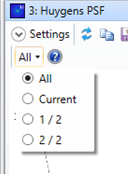We share a method of simulating Direct interference Laser Patterning in Zemax OpticStudio, including a Top Hat envelope if desired.
DLIP system optical modelling using ZEMAX OpticStudio software
Alexander Brodsky and Natan Kaplan
HOLO/OR
Keywords: optical design, ZEMAX Laser Surface Texturing, Direct Laser Interference Patterning
Abstract
In the last few years there has been a growing interest in utilizing Direct Laser Interference Patterning (DLIP) for surface structuring with high-power short pulse lasers. As Holo/Or is a major supplier of the high-power diffractive optical elements (DOEs) used in many DLIP systems, we felt the need to provide system integration support for our customers in this field.
As a part of our unwavering commitment to customer support, we have shared a Zemax OpticStudio design file, developed in-house, of the DLIP optical system.
Our model allows one to simulate nominal performance, as well as tolerances. It can easily be customized for any optical parameters; such as wavelength, beam size, splitting angles, number of orders, focal length, etc.
We hope that this tutorial will help professionals developing DLIP systems to better model their system and explore technical issues, including integration of our DOEs into their system.
You are welcome to download the source file from the link placed at the bottom of the document.
1. Detailed description of the simulation model
The file includes a four-beam interference system with a Top Hat beam shaper as described in the reference 1 . In figure 1.a. the system layout from the reference. is shown and in figure 1.b. a 3D layout of a similar system simulated using Zemax OpticStudio.
Simulation parameters are:
- Wavelength: 1053nm
- Input beam: 4mm
- An Angular Diffractive square Top Hat beam shaper with an image size of 1x1mRad
- A Diffractive Beam Splitter 2×2 beams with period 4 um
- A collimating prism with four zones, placed 55 mm after the beam splitter.
- Ideal focusing lens with EFL 100mm

The file was prepared in sequential mode, which has certain advantages in analysis methods for coherent systems.
In figure 2. we show the Lens Data window. In line 2 we placed a Top Hat beam shaper BlackBox file, followed by two orthogonal Diffraction Grating surfaces that model a 2×2 beams beam splitter. More details about modeling Diffractive Beam Splitters can be found in our tutorial
Surfaces 10 and 11 construct a single prism placed with a coordinate break to collimate the split beams. Coordinate break with Z axis rotation and shift for X and Y Axis so that the prism always collimates the rays coming out of the diffraction grating.
Each of the four split beams has an individual configuration that can be seen in the Multiconfiguration editor in figure 3. Diffractive order numbers, Z rotation angle and X or Y shift of prism of Coordinate Break are defined as the parameters.
2.Analysis

Huygens PSF was chosen for analysis, as it is a more universal method. To see the interference, choose in the properties of the Huygens PSF the option to show all configurations together.
In figure 4 (left) we show the real intensity results from the reference article vs our model of a similar system.
3.Summary
Holo/Or has developed an effective simulation tool for a DLIP system. You are welcome to contact us for more details, help in design, and an offer for the various DOE components in the DLIP setup you design.
Download link to DLIP simulation
Click here for a PDF version of this article.
More articles for DLIP (you are welcome to send us your article, and we will add it to the list)
References:
1. El-Khoury, Mikhael & Voisiat, Bogdan & Kunze, Tim & Lasagni, Andrés. (2018). Utilizing Fundamental Beam-Mode Shaping Technique for Top-Hat La-ser Intensities in Direct Laser Interference Patterning. Journal of Laser Micro Nanoengineering. 13. 268-272. 10.2961/jlmn.2018.03.0021.
2. Beam Splitter in Zemax tutorial
3.Charipar, Nicholas, et al. “Hierarchical laser patterning of indium tin oxide thin films.” Optical Materials Express 9.7 (2019): 3035-3045.
4.Garliauskas, Mantas, Evaldas Stankevičius, and Gediminas Račiukaitis. “Laser intensity-based geometry control of periodic submicron polymer structures fabricated by laser interference lithography.” Optical Materials Express 7.1 (2017): 179-184.
5.Stankevičius, Evaldas, Elena Daugnoraitė, and Gediminas Račiukaitis. “Mechanism of pillars formation using four-beam interference lithography.” Optics and Lasers in Engineering 116 (2019): 41-46.
6.Nakata, Yoshiki, Masataka Yoshida, and Noriaki Miyanaga. “Parallel fabrication of spiral surface structures by interference pattern of circularly polarized beams.” Scientific reports 8.1 (2018): 1-9.
7.Teutoburg-Weiss, Sascha, et al. “Development of a Monitoring Strategy for Laser-Textured Metallic Surfaces Using a Diffractive Approach.” Materials 13.1 (2020): 53.
8.Knorr, Fabian, et al. “Large-angle programmable direct laser interference patterning with ultrafast laser using spatial light modulator.” Physics Procedia 83 (2016): 1170-1177.
9.Fu, Yangxi, et al. “Picosecond Laser Interference Patterning of Periodical Micro-Architectures on Metallic Molds for Hot Embossing.” Materials 12.20 (2019): 3409.
10.Alamri, Sabri, et al. “On the interplay of DLIP and LIPSS upon ultra-short laser pulse irradiation.” Materials 12.7 (2019): 1018.
11.Aguilar-Morales, Alfredo I., Sabri Alamri, and Andrés Fabián Lasagni. “Micro-fabrication of high aspect ratio periodic structures on stainless steel by picosecond direct laser interference patterning.” Journal of Materials Processing Technology 252 (2018): 313-321.
12.Rößler, Florian, Tim Kunze, and Andrés Fabián Lasagni. “Fabrication of diffraction based security elements using direct laser interference patterning.” Optics express 25.19 (2017): 22959-22970.
13.Voisiat, Bogdan, et al. “Development of an Analytical Model for Optimization of Direct Laser Interference Patterning.” Materials 13.1 (2020): 200.
14.Milles, S., et al. “Influence of roughness achieved by periodic structures on the wettability of aluminum using direct laser writing and direct laser interference patterning technology.” Journal of Materials Processing Technology 270 (2019): 142-151.
15.Cardoso, J. T., et al. “Superhydrophobicity on hierarchical periodic surface structures fabricated via direct laser writing and direct laser interference patterning on an aluminium alloy.” Optics and Lasers in Engineering 111 (2018): 193-200.
Subscribe to our newsletter
Fill in the form below and stay updated with the newest technologies, industry applications and upcoming events.







